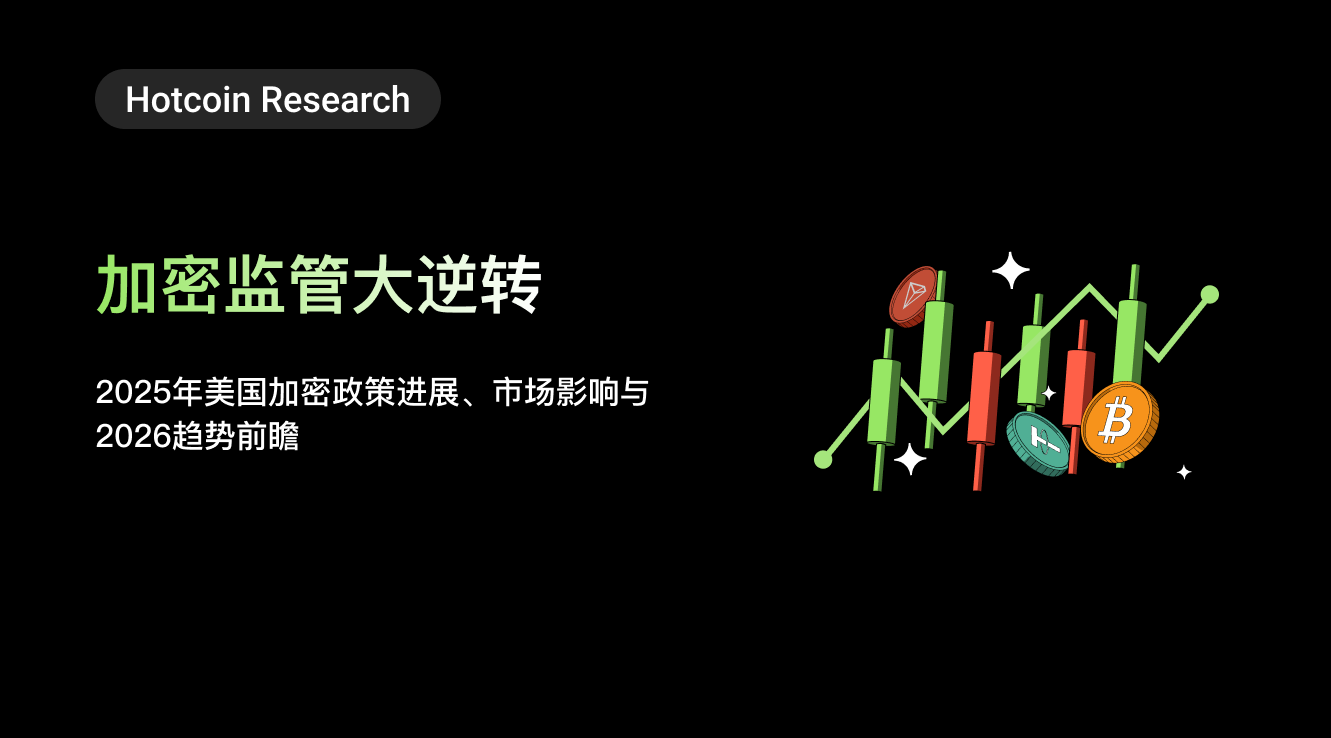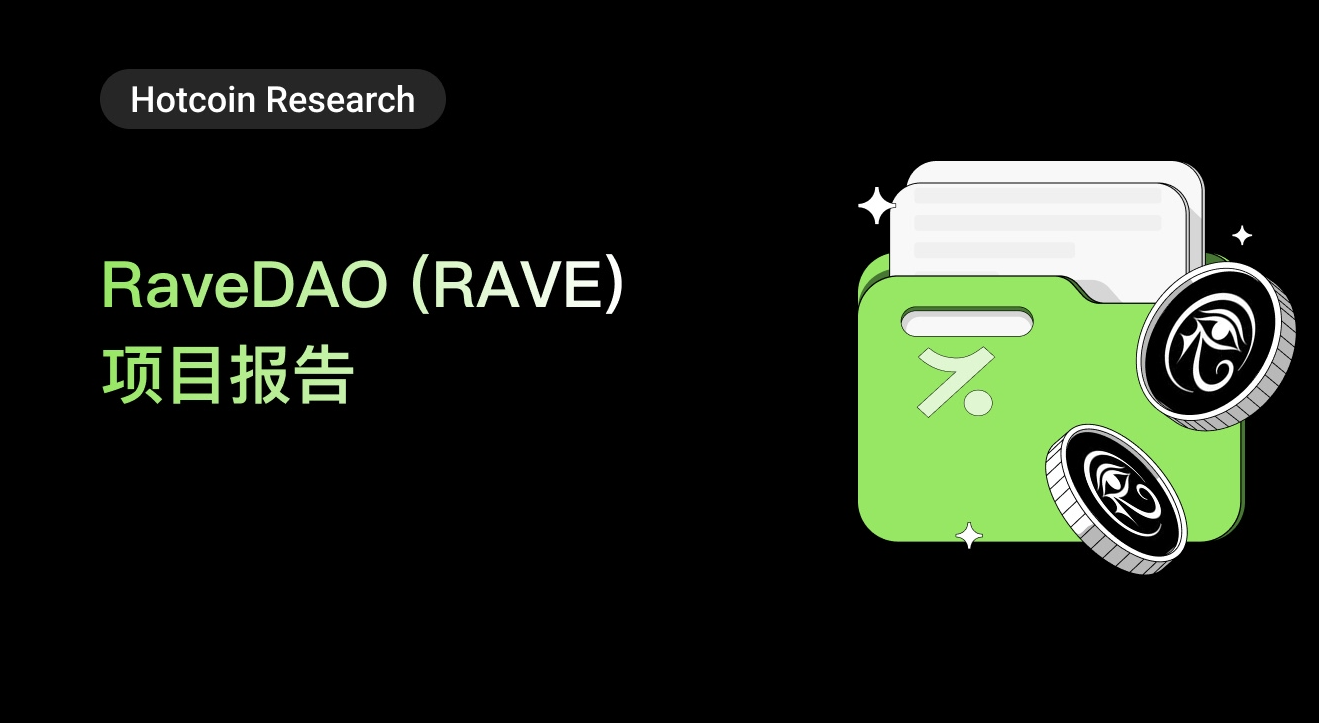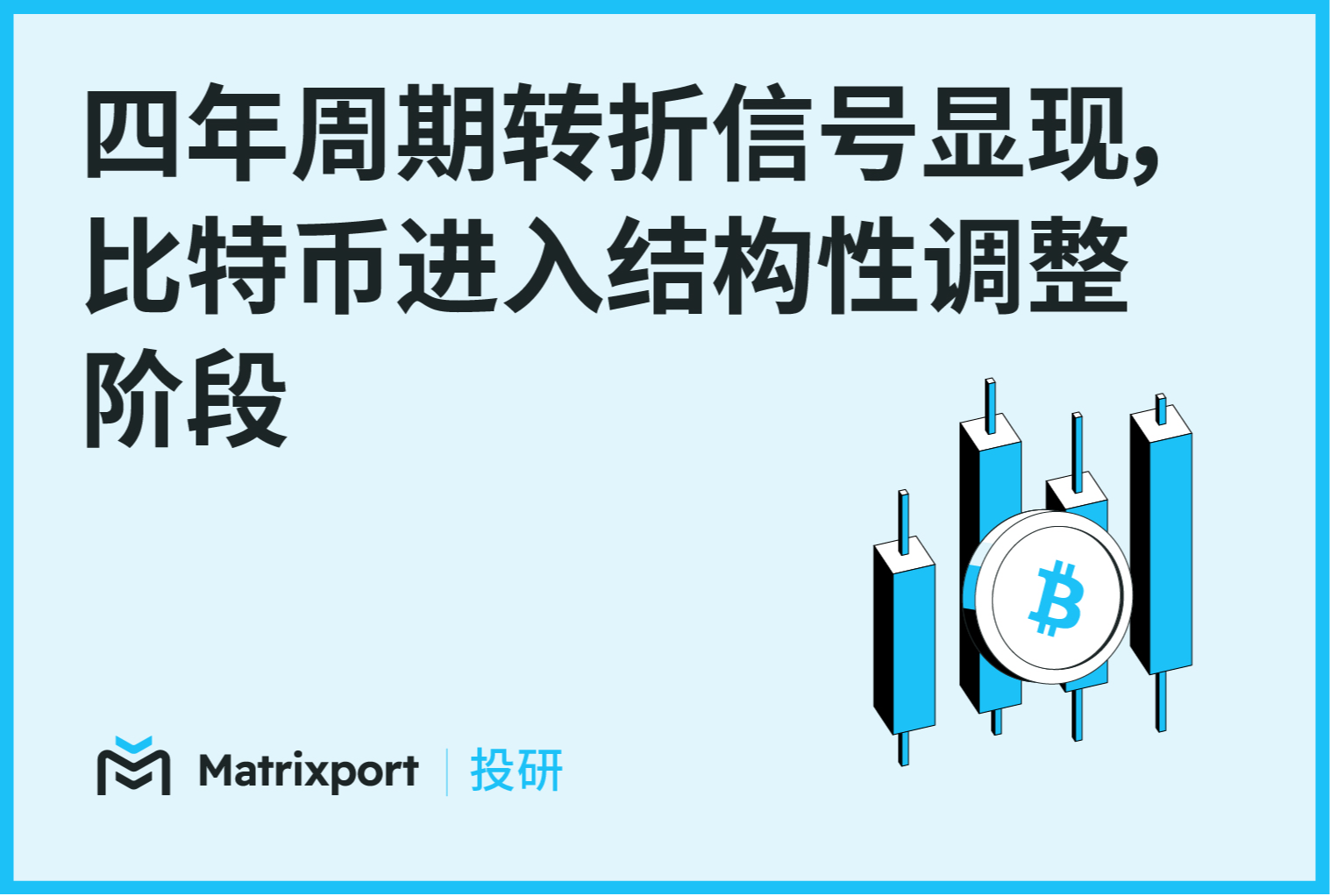In 2011, a 17-year-old Russian-Canadian boy initially wrote articles for a website called "Bitcoin Weekly," earning 5 bitcoins per article. "This was my first real job, and my hourly wage was about $1.30," he later recalled.
Those 5 bitcoins are worth $600,000 today—a rise of hundreds of thousands of times that witnesses the frenzied growth of the entire cryptocurrency era.
Even more astonishing is that Ethereum, created by this boy, Vitalik Buterin, has developed at a pace comparable to Bitcoin itself: now with a market value of over $400 billion, it supports more than $5 trillion in transactions annually.
Please follow this article as we look back at the ten years since the launch of the Ethereum genesis block, which also marks a decade of fervor in the blockchain industry. We will see how he transformed from a $1.30-per-hour writing youth into the infrastructure that changed the operational logic of the entire digital world, and what technological grassroots changes led to the migration of the superstructure.
Prehistoric Story—Bitcoin is the Beginning of Dreams
From Bitcoin Inspiration to Ethereum Creator
In 2013, the soaring price of Bitcoin ignited Vitalik's limitless imagination, but it also made him aware of Bitcoin's limitations. As a writer for "Bitcoin Magazine," he delved deeper into the Bitcoin community but found that this revolutionary financial system faced significant challenges in expanding beyond mere financial products if it were to switch to new programmable goals.
At that time, the concept of smart contracts was still extremely vague—there were no definitions, no samples, and no direction.
In the initial vision, contracts were merely scripts supporting some fixed functions—such as simple multi-signatures, time locks, or bilateral contracts like Mastercoin, where participants A and B both invested funds and then distributed profits according to a preset formula. This scripting language was not Turing complete; it could only describe the terms of the relationship between the two parties and was far from being a true "world computer," let alone intelligent.
Vitalik argued to Bitcoin core developers that the Bitcoin platform should have a more comprehensive programming language for developers. However, the conservatism and minimalist philosophy of the Bitcoin community fundamentally conflicted with Vitalik's vision of a more universal and open blockchain. Moreover, at that time, various scaling solutions in the market were merely patching up existing systems, and no one dared to propose a completely redesigned solution.
Thus, he made a decision that, in hindsight, truly changed the world: to develop a new platform.
With a forward decision made, the path backward was unclear. Although it was a new platform, how to design and implement it was a significant issue.
A turning point came at the end of 2013 during a long walk in San Francisco. He suddenly realized that contracts could be generalized—if it were a smart contract, it could itself be a fully mature account, capable of holding, sending, and receiving assets, and even maintaining permanent storage of some state. Why not go further and break the script that describes fixed relationships to design a virtual machine capable of executing arbitrary computations?
The initial design of Ethereum even adopted a register-based architecture (as opposed to the later stack-based architecture) and included a novel fee mechanism: with each computational step executed, the contract's balance would decrease slightly, and if the contract funds were exhausted, execution would stop. This was the early prototype of the "contract paid" model, which later evolved into the familiar "sender pays" and Gas system.
At the end of 2013, Vitalik wrote the Ethereum white paper, which defined the goal—to create a general-purpose decentralized computing platform where anyone could deploy and run decentralized applications, not fixed-function scripts, but a truly Turing-complete computing environment.
However, there was a significant gap to bridge from the ideal vision to achievable technical specifications. At this time, Gavin Wood's involvement became a critical turning point. In 2014, Gavin Wood wrote the famous "Ethereum Yellow Paper," which is the formal technical specification for the operation of the Ethereum virtual machine.
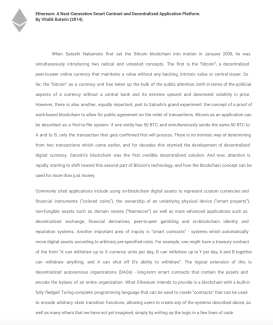
https://ethereum.org/content/whitepaper/whitepaper-pdf/Ethereum_Whitepaper_-_Buterin_2014.pdf
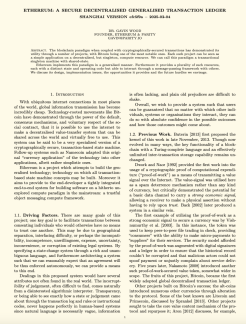
https://ethereum.github.io/yellowpaper/paper.pdf
The white paper depicted the "why" and "what," while the yellow paper precisely defined "how to do it." The combination of these two documents brought Ethereum from concept to reality.
Key Technical Decisions and Evolution in Berlin
From 2014 to 2015, Berlin became the spiritual home of Ethereum. Vitalik often "pilgrimed" in the Bitcoin Kiez area of Berlin, with Room 77 becoming a gathering place for the early crypto community. In an office just 1.5 kilometers from Room 77, at Waldemarstraße 37A, the core team of Ethereum was coding day and night.
During this phase, the Ethereum protocol underwent countless technical iterations: transitioning from a register-based architecture to a stack-based architecture, evolving from the "contract paid" model to the "sender pays" Gas system, and changing from asynchronous internal transaction calls to synchronous execution. Many decisions had far-reaching impacts.
For example, the EVM (Ethereum Virtual Machine) unified the 256-bit integer model, initially to accommodate the common bit width of hash functions and cryptographic algorithms while avoiding overflow risks in design. Although it seemed overly conservative at the time, it naturally adapted to the complex high-precision mathematical operations in DeFi (such as fixed-point, multiplication, and division rounding), also avoiding precision issues found in JS/float-like languages.
Additionally, if a transaction exhausts Gas, the entire execution will roll back rather than partially complete. This design eliminated the entire attack surface of "partial execution attacks," becoming the cornerstone of all smart contract security later on. Moreover, this design had economic incentives; on one hand, technically, the Gas required for contract execution could not be predicted beforehand, and on the other hand, because failures would incur losses, senders were more incentivized to control costs and behavior, avoiding blind transaction sending.
The technical creativity of everyone brought many unexpected surprises. For instance, Vitalik initially envisioned an asynchronous contract calling model, but Gavin Wood, considering engineering and semantic consistency during implementation, naturally adopted synchronous calls. This seemingly unintentional shift laid the critical technical foundation for the later composability of DeFi—allowing one contract to synchronously return execution results when calling another, creating the predictability and atomicity of "money Legos."
It is important to note that Ethereum's DeFi applications are highly interdependent and do not exist in isolation. For example, lending protocols use DAI/USDC as collateral, while stablecoin mint modules call Chainlink for oracles, and many market-making protocols leverage Aave and Compound for leverage. In this series of interactions, synchronous calls played a crucial role, but they also had pros and cons. Due to the performance expansion challenges of synchronous calls, Ethereum had to choose more complex scaling solutions later on (see the L2 section below).
Additionally, the well-known POW mining algorithm underwent multiple iterations, from the Dagger algorithm proposed by Vitalik to Dagger-Hashimoto, developed in collaboration with Thaddeus Dryja, and then to Ethash, which emphasized ASIC resistance. Throughout these processes, various directions were explored, such as adaptive difficulty, memory-hard structures, and random access circuits.
Of course, many difficulties brought unexpected joys, which naturally became subsequent technical debts. In 2025, when Vitalik proposed replacing the EVM with RISC-V, he admitted, "Ethereum has often failed to maintain simplicity in its history (sometimes due to my own decisions), leading to excessive development expenditures and various security risks, often in pursuit of benefits that have proven to be illusory."
A Historic Moment: July 30, 2015
On July 30, 2015, Vitalik still remembers the scene in the Berlin office that day: "Many developers gathered together, and we were all watching the block count on the Ethereum testnet reach 1,028,201, as this marked the automatic launch of the Ethereum mainnet. I still remember us sitting there waiting, and then it finally reached that number, and about half a minute later, Ethereum blocks started being generated."
At that moment, there were fewer than 100 developers in total for Ethereum, and the entire ecosystem was merely a technical experiment. The first decentralized Twitter application, "EtherTweet," had an interface as rudimentary as "the Wright brothers' plane," and each tweet required a high on-chain fee. Smart contracts were still toys for a few geeks, and DeFi, NFTs, and Layer 2 existed only in the imagination of white papers.
Now, if you search for that address on Google Maps, you can still see it marked as "Ethereum Network Launch (30/07/2015)" along with a group photo of the early core members of Ethereum—one of the most important photos in crypto history.
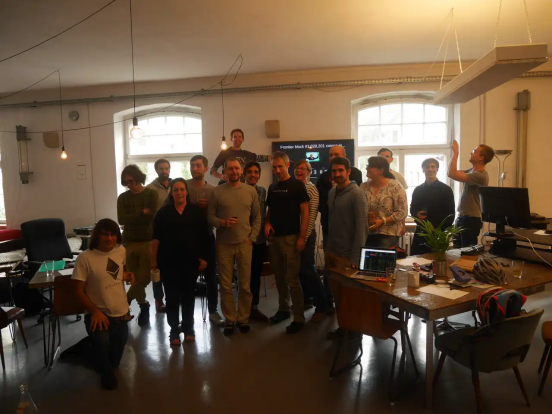
On July 30, 2025, as Ethereum celebrates its tenth anniversary, as of the first half of 2025:
In the first quarter of 2025, a record 6.1 million wallets participated in on-chain governance voting.
Ethereum adds approximately 350,000 new wallets weekly, thanks to users joining through Layer 2s.
As of March 2025, the number of active Ethereum wallets reached 127 million, a year-on-year increase of 22%.
Leading the stablecoin market with a market cap of $82.1 billion, accounting for 60.0% of the total market cap.
The total locked value (TVL) of various DeFi protocols exceeded $45 billion.
Uniswap's daily trading volume surpassed $2.1 billion, and lending platforms like Aave and Compound collectively held over $13 billion in locked assets.
In the past 12 months, Ethereum recorded over 28,400 GitHub commits in its core repository.
The number of active developers contributing to Ethereum-related projects is currently over 5,200.
There are many more data points that the author will not list here. The point being made is that this "marginal experiment," which once had fewer than 100 developers involved, has grown into the largest development platform and ecosystem in the Web3 world.
Over the past decade, Ethereum has transformed from a few daily transactions to processing $5 trillion in value annually, from transaction fees of several dollars to costs of less than one cent on Layer 2, from PoW mining consuming as much energy as a small country to PoS mechanisms that consume less energy than a single building, and from the rudimentary EtherTweet demo application to a mature DeFi ecosystem where 80% is priced in ETH—each number carries the relentless efforts of countless developers and the trust choices of users. And when the U.S. SEC approved nine ETH spot ETFs, with first-day trading volume exceeding $1 billion, this once "marginal cryptocurrency experiment" has become a large-scale asset ranking among the top globally, at the core of the mainstream financial system, causing increasingly far-reaching impacts.
However, the journey from a boy in the Berlin office to the creator of a new generation of global financial infrastructure has not been smooth sailing. Over the past decade, Ethereum has experienced the growing pains of technological upgrades, the trials of hacking attacks, the baptism of market cycles, and countless critical decisions concerning its survival. Each crisis has been a reshaping, each upgrade a transformation, and each controversy a growth opportunity. It is these ups and downs at critical junctures that have shaped the Ethereum we see today.
Let us return to those decisive moments and re-examine how this legend was forged in the storm.
A Decade of Journey—Key Nodes and Evolution Logic
2015-2017: From Genesis to Hard Forks and the ICO Craze
The launch of the Ethereum mainnet that summer marked the beginning of the smart contract era.
Early Ethereum resembled an experimental technology showcase rather than a truly usable product. Most of the applications running on the network were simple demo applications—such as EtherTweet (a decentralized Twitter clone), WeiFund (a crowdfunding platform), and various rudimentary voting contracts.
The instability of gas prices made every interaction feel like a gamble, sometimes taking an hour to get on-chain. What was even more frustrating for developers was that the Solidity language was still very immature, with the compiler frequently exhibiting strange bugs (such as variable shadowing, stack overflow, and jump logic errors), and the security of smart contracts often relied on the personal experience of developers.
Despite the technological immaturity, the Ethereum community exhibited an unprecedented idealistic enthusiasm. Weekly developer meetings were always packed with programmers from around the world discussing how to use smart contracts to reconstruct the entire world—from autonomous organizations to prediction markets, from identity systems to supply chain management, which indeed flourished in hindsight. Moreover, this optimism was mixed with an almost fervent belief: code is law, mathematics is truth, and decentralization is freedom.
Carrying this sentiment, in May 2016, a project called "The DAO" launched on Ethereum, hailed as "the largest crowdfunding experiment in human history." In just 28 days, it raised $150 million worth of ETH (accounting for 14%-15% of the entire network), becoming the largest venture capital fund in the world at that time.
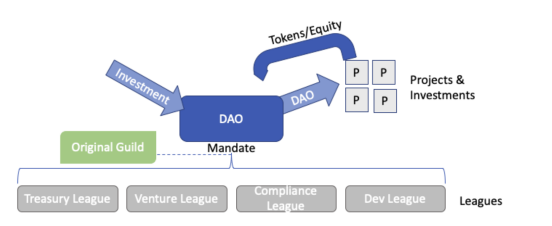
Source: The DAO White Paper: https://github.com/the-dao/whitepaper
At this point, a massive crisis quietly approached. On June 17, a hacker exploited a reentrancy attack vulnerability in The DAO's smart contract, successfully stealing 3.6 million ETH (about 5% of the total Ethereum supply at the time).
The core of this attack lay in the design of the splitDAO function within The DAO smart contract, which had a typical reentrancy vulnerability—a classic attack pattern that would later be included in smart contract security textbooks.
When a user called the function to separate the DAO, the contract would execute the following steps: first, it would send rewards to the user via the withdrawRewardFor function, and only then would it update the user's balance. The problem was that the withdrawRewardFor function ultimately used the low-level call.value() method to send ETH to the recipient (using such a low-level transfer mechanism was also a point of concern). Subsequently, when the recipient (the attacker) received the ETH, their fallback function was triggered, which immediately called the splitDAO function again. This created a reentrancy attack, as the first call had not yet completed (the balance had not yet been updated), allowing the attacker to repeatedly withdraw funds based on the same balance.
The attacker deployed two identical malicious contracts, achieving up to 29 recursive withdrawals. Each withdrawal was calculated based on the same original balance, ultimately successfully transferring tens of millions of dollars' worth of ETH to their controlled sub-DAO. Ironically, this vulnerability had been discovered and warned about by several developers before the attack occurred, but under the belief of "code is law," no one thought the contract's operation should be paused.
This plunged the entire Ethereum community into an unprecedented philosophical crisis. On one hand were the technical purists, who insisted that the immutability of the blockchain was sacred and inviolable, believing that while the attack was morally wrong, it was "legitimate" from a technical standpoint because the attacker was merely acting according to the contract's code logic. On the other hand were the pragmatists, who believed that protecting investors' interests and maintaining the Ethereum ecosystem was more important than abstract principles.
In response, Gavin Wood (one of the co-founders, former CTO, and author of the Yellow Paper) stated in a public interview: "The blockchain should be immutable, and the code on-chain should be the true controlling logic." But he also admitted, "If I saw someone being robbed on the street, I would be willing to step in to stop the robbery and return the stolen goods."
Vitalik Buterin later wrote in his blog: "I spent the night sleepless, repeatedly thinking about what true decentralization is. If we can modify history at will, what difference is there between Ethereum and a traditional database? But if we watch the attacker take away the community's funds, how do we face those who trust us?"
After intense community debate, Vitalik ultimately chose to implement a hard fork (which is the story of the split between Ethereum and Ethereum Classic). He later reflected, "We learned a harsh truth—absolute decentralization is a beautiful ideal, but in the real world, we must find a balance between pure principles and human needs." This lesson has been reflected in every subsequent network upgrade: technical decisions must serve the overall interests of the community, rather than abstract ideologies.
If the DAO incident was Ethereum's rite of passage, then the ICO craze of 2017 was its adolescence. That year, over 50,000 ERC-20 token contracts were deployed on the Ethereum network, raising over $4 billion, and blockchain began rewriting the rules of traditional venture capital.
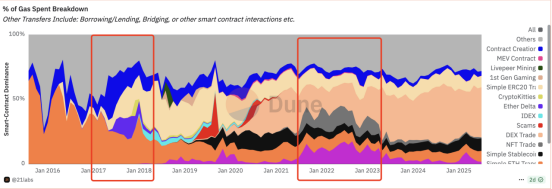
Source: Dune: https://dune.com/queries/2391035/3922140
Historical data shows that by analyzing gas consumption, a large number of contracts were generated during 2017-2018 (the yellow part in the left red box of the chart), and ERC20 transfers became popular, transforming on-chain assets from native coins (ETH) to a variety of ecological applications.
Additionally, a digital cat game called CryptoKitties occupied 15% of the network's transaction capacity within just a few days, causing gas fees to soar from a few cents to tens of dollars, and transaction confirmation times extended from minutes to hours. This experience served as a lesson, leading to the London upgrade completed in 2021, which allowed the second wave of NFT craziness (the gray part in the right red box of the chart) to proceed without chaos.
The ecological bursts that occurred in each cycle continuously raised the demand for on-chain space, making people deeply aware of how far the processing capacity of 15 transactions per second was from the grand vision of a "global computer."
2018-2022: Forging the Future in Silence—From Technical Accumulation to Ecological Explosion
Ongoing Technological Revolution (2018-2022)
When the ICO bubble burst in 2018 and speculators exited the scene, the number of Ethereum developers did not decrease but rather increased. It was during this forgotten quiet period that Ethereum completed a series of key technological upgrades, laying a solid foundation for the subsequent ecological explosion.
Almost annual upgrades followed, with the Byzantium fork, Constantinople fork, and Istanbul fork successively released. Many changes were relatively unnoticed by users, bringing more underlying transformations. For instance, by reducing the block reward from 5 ETH to 3 ETH, Ethereum began to seek a balance between inflation and security; these upgrades also introduced various underlying support energies for Layer 2 scaling, including pre-compiled zero-knowledge proof technologies like zk-SNARKs. The introduction of the CREATE2 opcode allowed multi-chain contracts to have deterministic address creation capabilities.
The real solution to alleviating the user experience of transaction congestion mentioned earlier is EIP-1559 from the London upgrade in 2021. This proposal addresses the flaws of the traditional "blind auction" mechanism through a dual mechanism of Base Fee and Priority Fee. Before EIP-1559, users had to guess the appropriate gas price—bidding too low could result in transactions not being packaged for a long time, while bidding too high would waste a lot of funds. Worse still, during network congestion, users often panic and significantly raise their bids, leading to a spiraling increase in fees and creating a "price war."
However, congestion did not disappear after EIP-1559, as it addressed the "price discovery" issue rather than the "capacity" issue.
The actual throughput of the Ethereum mainnet did not significantly increase—it still processes about 15 transactions per second. It merely made prices more predictable during congestion due to the automatic increase of the base fee, until some users abandoned usage due to high prices. This is akin to building better toll booths, making the queue more orderly and the fees more transparent, but the number of lanes on the highway itself did not increase.
Real "road expansion" still relies on Layer 2 solutions—this is why rollup technologies like Arbitrum and Optimism, as well as EIP-4844's blobs, have become central to Ethereum's scaling roadmap.
During this period, there was also a fundamental technological shift: the evolution of Ethereum's consensus mechanism. Initially, Ethereum inherited Bitcoin's PoW model, but it began exploring PoS solutions in 2015, going through various technical routes such as Casper FFG and Casper CBC, until the successful launch of the Beacon Chain finally determined the direction.
On December 1, 2020, 520,000 ETH were staked in just one month, and by the successful launch of The Merge in 2022, Ethereum's energy consumption was reduced by 99.95%. This not only met the environmental requirements of regulators and investment institutions but also laid the foundation for future sharding expansion and further optimization of the Beacon Chain, truly achieving a transition from "mining equals security" to "staking equals governance."

Source: Ethereum Staking Data: https://dune.com/hildobby/eth2-staking
As of today, Ethereum has over 1.1 million validators, with 3.6 million ETH locked for staking, accounting for approximately 29.17% of the total supply. Such a scale of staking participation provides unprecedented economic security for Ethereum—if an attacker wants to launch a 51% attack, the cost would be in the millions of ETH, making it extremely expensive. Moreover, the participants in staking are diverse, making the overall security even more difficult to shake.
However, consensus does not have to remain unchanged over the long term. The successful transition of Ethereum to PoS without losing its degree of decentralization is largely due to its years of operation under PoW, resulting in a highly decentralized token distribution. This inherent advantage is not something that any PoS chain can easily match. On the other hand, the existing consensus still brings limitations to user experience.
For example, Ethereum still operates under a finality delay mechanism, requiring multiple epochs to confirm block finality, which is inconvenient in cross-chain and rollup settlement scenarios. Therefore, there is a future Single Slot Finality (SSF) plan aimed at compressing finality to a single slot (12 seconds). There is also the concept of Beam Chain, which provides several possible directions for future consensus design, such as allowing validators to participate in consensus without owning the full state, enhancing the feasibility of lightweight clients. Coupled with designs like EIP-4844 and Danksharding, the Beam model can support more flexible data access paths, accelerating the decoupling of validators and executors.
Thus, the path of consensus remains ever-evolving, continuously adapting to higher levels of decentralization requirements and matching user experience.
The Ecological Miracle of DeFi/NFT Summer (2020-2023)
After years of infrastructure upgrades, when the technological foundation is strong enough, innovation will emerge like bamboo shoots after a rain.
In the summer of 2020, Compound's liquidity mining served as a singular point that ignited the DeFi revolution, but what truly made this revolution possible was the technological foundation accumulated over the previous three years. Uniswap's automated market maker model, Aave's flash loans, and Curve's stablecoin trading optimizations—each innovation was built on Ethereum's increasingly mature smart contract infrastructure. Moreover, the interdependence of leading DeFi protocols formed a true "money Lego" ecosystem, and this composability is the crystallization of Ethereum's years of technological accumulation.
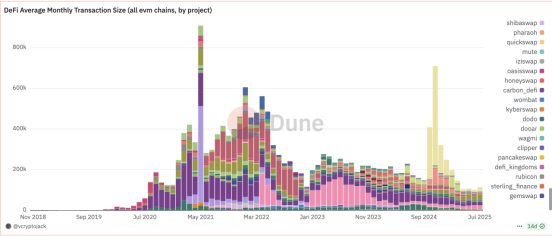
Source: Dune: https://dune.com/queries/4688388/7800121
This chart shows the trend of DeFi application transactions across various EVM-architected chains. Although some EVMs are not Ethereum or its L2 ecosystem, it can be seen that from the most disruptive period in 2021, several major players have emerged, and now it is hard to discern how many colors (projects) are blooming on various chains, each satisfying diverse financial needs on-chain.
On the other hand, from CryptoPunks to Bored Ape Yacht Club, NFTs have not only redefined digital ownership but also allowed Ethereum to find a new value anchor in the fields of digital art and culture. The rise of OpenSea/Blur demonstrates Ethereum's immense potential as a cultural infrastructure, and the foundation of all this is Ethereum's well-established token standard system.
It is worth mentioning that even now, the single project of CryptoPunks (as shown in the first chart, the gray part) still occupies a significant share of the entire NFT market. It even appeared before the NFT standard, with the contract itself built-in with trading market functionality, allowing for direct interaction with the chain to complete order transactions without needing a front end.
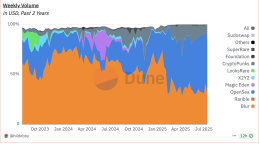
Source: Dune: https://dune.com/queries/2704953/4502619
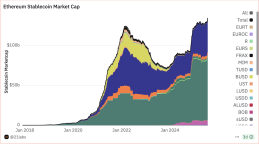
Source: Dune: https://dune.com/queries/2452131/4030703
In the stablecoin sector, after the DeFi Summer of 2021, over $130 billion in funds have been divided among USDC, USDT, DAI, and others.
Looking back over the past decade, from the initial ERC-20 to ERC-721, ERC-1155, and now the emerging standards being explored such as ERC-3525 and ERC-3475, Ethereum has built a digital framework capable of expressing almost all asset types in the real world.
Token Standards
Type
Main Features
Application Scenarios
ERC-20
Fungible Token
Divisible, Replaceable
Currency, Points, Governance Tokens
ERC-721
Non-Fungible Token
Uniqueness, Indivisible
Artworks, Collectibles, Identity Proof
ERC-1155
Multi-Standard Token
Mixed Fungible + Non-Fungible
Game Items, Batch NFT Management
ERC-3525
Semi-Fungible Token
Slot Group Management, Supports Value Transfer
Bonds, Financial Assets, Fractional Investments
ERC-3475
Contractual Debt Token
Highly Customizable, On-Chain Contract Storage
Debt Contracts, Business Agreements, Complex Protocols
These five standards form a complete expression system from simple currency to complex financial contracts, and there are more standards that have not yet been finalized but are gradually being adopted in different applications, leaving room for continuous development.
This is the source of innovation: a more open protocol layer builds a market that allows for more intelligent contributions. Through EIPs (Ethereum Improvement Proposals), it does not create products but serves as a mechanism for proposing improvements to Ethereum, allowing protocol participants to reach consensus at different levels, whether regarding contract standards, client implementations, or process optimizations related to user experience, ensuring that every improvement suggestion can be recorded in history, undergo technical review, and ultimately be adopted or rejected by the network.
2023-2025: The Differentiation of the Rollup-Centric Era
Ethereum's Scaling Path: Layer 2
This path has come a long way, and Layer 2 has now become an important part of the Ethereum ecosystem, accounting for 85% of transaction counts, 31% of transaction volume, and the number of active addresses reaching 3-4 times that of the Ethereum mainnet. Behind this prosperous scaling success lies a more complex process of comprehensive reconstruction of technology and business models.
As mentioned earlier, Ethereum's TPS was 15/s; so what is the current overall actual TPS of the Ethereum ecosystem?
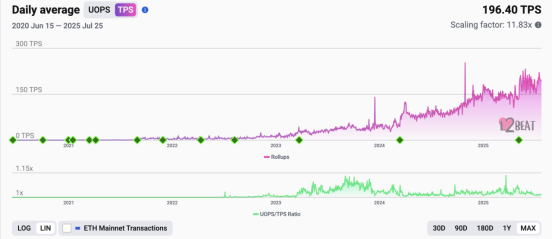
Source: L2beat: https://l2beat.com/scaling/activity
Vitalik once used blobs to calculate: using EIP-4844, we now have 3 blobs per slot, with each slot's data bandwidth being 384 kB, which translates to 32 kB per second. Each transaction on-chain requires about 150 bytes, resulting in approximately 210 tx/sec.
Comparing with the actual numbers on L2beat, it is indeed similar, achieving a tenfold increase in just a few years, which is quite powerful.
How should we understand the blobs of EIP-4844? There is an interesting website that allows you to feel the difference.

Source: TxCity: https://txcity.io/v/eth-arbi
First, let’s look at the left side, which shows Ethereum's block production process. Each person in the diagram represents a transaction interacting with a certain application, and then they enter different blocks based on the gas price, completing the packaging process.
Now, let’s look at the right side, which represents one of Ethereum's Layer 2 solutions, Arbitrum One. Similarly, each person in the diagram represents a transaction interacting with a certain application, and they leave a note at the counter. After a certain period, a postman comes to collect all the transactions, forming the current blob, and then this postman goes to the Ethereum mainnet on the left to submit it into a specific compartment.
In this way, blobs prevent unnecessary data from being written to the Ethereum mainnet for long periods, only serving a purpose during verification and for a limited time, thus reducing Layer 2 fees by 90%.

Source: L2beat: https://l2beat.com/scaling/costs
However, objectively speaking, the market's view on this is mixed, as Layer 2 has not brought a proportional increase in revenue to Ethereum. The previous EIP-1559 introduced a deflationary mechanism through the burning of ETH, which was met with cheers from the community, as deflation often represents an increase in value for vested interests.
But today, with 85% of transactions moving to Layer 2, MEV revenue is naturally intercepted by various rollups, and the mainnet has fallen back into an inflationary state. Inflation itself can affect the security of Ethereum staking (a currency that depreciates over time tends to be held for the long term).
From my perspective, Ethereum has actively chosen to forgo profits in exchange for ecological prosperity, not adopting the traditional "corporate" approach—maintaining profits through increased fees or limiting competition—but instead opting to share benefits, repositioning itself as a highly decentralized, permissionless Layer 2 issuance protocol.
This strategy has led to a collision of various viewpoints. Regardless, it can be said that we are witnessing a new model of value capture—ETH no longer relies on a burning mechanism to control supply to simply gain value, but instead captures value through powerful network effects in an ever-expanding ecosystem.
Furthermore, compared to the early scaling roadmap, we are now shifting from the early vision of "homogeneous sharding" to the reality of a "heterogeneous ecosystem." The sharding concept from 2016 envisioned creating multiple identical EVM copies processed by different nodes; today’s Layer 2 has practically realized this vision but introduced a fundamental difference—each "shard" is created by different participants, following different standards, forming a de facto heterogeneous network.
The traditional "single-chain governance" model has given way to a "multi-chain federation," where each Layer 2 has its own governance mechanism, economic model, and community culture. Base can focus on providing a seamless experience for Coinbase users, Arbitrum can pursue maximum EVM compatibility, not to mention unique experiences like ZkEVM, which cannot be achieved under a single chain architecture.
However, this heterogeneity also brings new challenges. How can using Ethereum feel like using a single ecosystem rather than 34 different blockchains? This is a more complex coordination challenge than The Merge, as it involves more participants, more dispersed interests, and a tighter time window.
The exploration of Layer 2 continues, but regardless of the outcome, Ethereum's "self-sacrifice" has already become one of the most unique experiments in blockchain history—one technical system actively relinquishing power for its ideals, and one protocol giving up monopolistic profits for ecological diversity.
This may be the best embodiment of Vitalik's statement: "The technical project and the social project are inherently intertwined."
2015-2025: A Decade-Long Journey of Account Abstraction
The vision of account abstraction is even older than Ethereum itself. It is a dream about "making technology invisible"—just as we don’t need to understand the underlying Unix system when using an iPhone today, blockchain users should not be forced to become cryptography experts.
Imagine a scenario where you need to remember a string of 12 random words to access your bank account; if you forget them, you can never retrieve your deposits, and if they are leaked, all your assets will be stolen. This sounds like a bug in a sci-fi novel, but it has been the real experience of blockchain users for the past decade.
This seemingly "pure" design of autonomy actually stems from a technical compromise in Ethereum's early days: EOA (Externally Owned Accounts) couples ownership and signing authority under the same private key. In simpler terms, your "ID card" is also your "bank password," and exposing the private key means opening the door and losing everything.
The root of this design comes from Ethereum's transaction structure—standard transactions do not have a "From" field but instead derive the sender's address through VRS parameters (i.e., user signatures).
Account abstraction aims to solve this "technical necessity" that binds user experience.
In November 2015, just four months after the launch of the Ethereum mainnet, Vitalik proposed EIP-101—the first account abstraction proposal. The vision at that time was radical yet simple: turn all accounts into smart contracts, making code, rather than private keys, the sole controller of the account.
But ideals are often more beautiful than reality. Ethereum carries a heavier historical burden than any new chain—millions of existing EOA accounts, assets worth hundreds of billions of dollars, and a vast and complex ecosystem. Any radical change could have catastrophic consequences.
Thus began a long technological journey:
The 2015 EIP-101 envisioned the blueprint for contract-based accounts.
The 2018 EIP-859 attempted to implement contract wallets at deployment.
The 2021 EIP-3074 sought to add smart contract functionality to EOAs.
The 2021 proposed ERC-4337, which went live in 2023, achieved account abstraction without changing the protocol layer.
The 2024 EIP-7702, based on EIP-3074, will ultimately achieve mainnet deployment in the 2025 Pectra upgrade.
This decade-long exploration has been like changing engines on a flying airplane—ensuring safety while achieving upgrades, with each step requiring extreme caution. EIP-7702 brings not only a change in technical architecture but also a foundational improvement in user experience. Let’s look forward to the upcoming future:
Passkey Technology: You no longer need to remember 12 mnemonic words; you can securely access your digital assets using Touch ID or Face ID.
Gmail Recovery: When you forget how to access your wallet, you can send a zero-knowledge proof to your Gmail using ZK Email technology, restoring wallet control without revealing any privacy. This sounds like magic, but it is indeed real technology.
One-Click Complex DeFi Operations: For heavy on-chain users, multiple transactions can be bundled together for execution—from borrowing to trading to staking complex operation sequences, all completed with one click, significantly reducing wait times and failure risks. Of course, this requires a reliable wallet to construct such transactions for you.
Looking back at the Pectra upgrade, we once again see Ethereum's reflection and persistence regarding future directions. The Layer 2 strategy has entered a stable execution phase, and while there are changes in the details of Ethereum's roadmap, the core goal remains consistent: to build a secure, decentralized, highly scalable, and easily verifiable green blockchain. The introduction of various user experience proposals represents Ethereum's relentless exploration to enhance competitiveness while ensuring decentralization—even in the face of fierce competition from a new generation of public chains.
Towards the Stars and the Sea—Moving Towards Openness and Fairness
On July 30, 2024, on the ninth anniversary of Ethereum, Vitalik posed a profound question of the era at EDCON: "The past ten years of Ethereum have been a decade focused on theory, and by 2024, we have this technology. In the next decade, we really must change our focus—not only considering Layer 1 but truly thinking about what impact we are actually having on the world."
Ten years ago, a 19-year-old boy was coding with his teammates in an office in Berlin, dreaming of creating a "world computer." Ten years later, his dream has partially come true: today’s Ethereum carries the flow of value worth trillions of dollars, connecting tens of millions of users worldwide and supporting an unprecedented decentralized financial ecosystem.
However, like all great innovations, Ethereum's story is far from over. From the trauma of the DAO Hack to the revelry of DeFi Summer, from the victory of The Merge to the differentiation of Layer 2, and the ups and downs of the decade-long journey of account abstraction, each crisis is a new beginning, and each controversy drives the process of evolution.
A decade has passed, and Ethereum remains that unfinished world computer, an ongoing myth. Early on, it gave up efficiency thinking, allowing Ethereum to operate as a protocol and become a resilient system.
It embodies humanity's collective imagination for a more open, fair, and autonomous digital future. And perhaps, that is its greatest value.
Disclaimer:
This article is for reference only. It represents the author's views and does not reflect the position of OKX. This article does not intend to provide (i) investment advice or recommendations; (ii) offers or solicitations to buy, sell, or hold digital assets; (iii) financial, accounting, legal, or tax advice. We do not guarantee the accuracy, completeness, or usefulness of such information. Holding digital assets (including stablecoins and NFTs) involves high risks and may fluctuate significantly. You should carefully consider whether trading or holding digital assets is suitable for you based on your financial situation. Please consult your legal/tax/investment professionals regarding your specific circumstances. You are responsible for understanding and complying with applicable local laws and regulations.
免责声明:本文章仅代表作者个人观点,不代表本平台的立场和观点。本文章仅供信息分享,不构成对任何人的任何投资建议。用户与作者之间的任何争议,与本平台无关。如网页中刊载的文章或图片涉及侵权,请提供相关的权利证明和身份证明发送邮件到support@aicoin.com,本平台相关工作人员将会进行核查。

